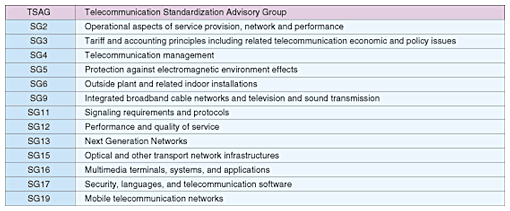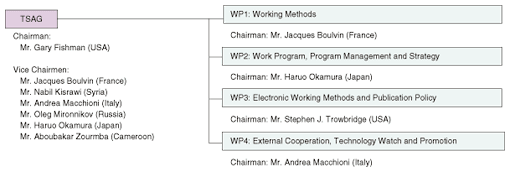 |
|||||||||||||||
|
|
|||||||||||||||
|
Global Standardization Activities Vol. 5, No. 8, pp. 33–36, Aug. 2007. https://doi.org/10.53829/ntr200708gls Trends in ITU-T TSAGAbstractThis article describes the trend in the activities of TSAG (Telecommunication Standardization Advisory Group) in the present study period (2005–2008) of ITU-T (International Telecommunication Union, Telecommunication Standardization Sector). TSAG is the advisory group that investigates the strategy and priority of operations in ITU-T as a whole or several Study Groups with common issues. The activities of TSAG indicate the general direction that ITU-T activities will take in the future.
1. Position, role, and scheduleThe Telecommunication Standardization Advisory Group (TSAG) [1] occupies the same hierarchical level as the Study Groups (SGs) in the organization chart of ITU-T (International Telecommunication Union, Telecommunication Standardization Sector) [2] in WTSA (World Telecommunication Standardization Assembly). WTSA is a general meeting of ITU-T that is held every four years. TSAG gives advice on working methods, strategies, and management issues to the director of ITU-T and to all the SGs.
The roles of TSAG and SGs are shown in Table 1, and the organizational composition of TSAG and the roles of Working Parties (WPs) are shown in Fig. 1. TSAG meetings are held at intervals of eight or nine months like other SG meetings. The venue is usually ITU headquarters in Geneva. The schedule of meetings during the current study period (2005–2008) is shown in Table 2. Four meetings have been held so far and two more are scheduled to be held. This article describes the trend in TSAG activities in this study period, providing an update to the previous article in January 2005 [3]. 2. Working methodsTo respond to the rapid development of information technology (IT) in the area of standardization and survive in this competitive environment among other standardization-related forums, ITU-T needs to improve the efficiency of its activities by improving its working methods. Various countries in Asia, Europe, and Africa had been asking for a change in the "single member state veto", which was allowed in the case of the approval of a recommendation. These countries considered that the veto caused a delay in the standardization process. After the end of the discussion at the 3rd TSAG meeting, the single member state veto was revised so that recommendations based on the Alternative Approval Process, which do not include policy or regulatory matters, could be approved unless two or more countries were in opposition. The unconditional replacement of "single member state veto" was prevented by opposition from the USA and Syria. Nevertheless, the resulting conditional change significantly accelerates the approval process. The structures of the existing FG (Focus Group) and JCA (Joint Coordination Activity) are insufficient to handle discussions about new research tasks studied by more than one SG or by organizations other than ITU, so a new Correspondence Group (CG) was established to study the working methods and organizational structure appropriate for such kinds of situations. In addition, ITU-T recognizes that there is no longer any difference between a contribution and a delayed document. ITU-T has promoted reform to improve its operational efficiency steadily. 3. Work programs, program management, and strategiesThe CG, which considers the reorganization of SGs, was established at the 4th meeting. It is chaired by the WP2 Chairman, Haruo Okamura. The discussion of SG reorganization will continue, mainly within this CG. Many new problems arose through the many meetings and discussions, and approaches for solving them were discussed. The statuses of several major problems in TSAG are described below. (1) Next Generation Network (NGN)There was a plan to reconsider NGN studies within two years of the last WTSA meeting in 2004. The inauguration of NGN-GSI (Global Standards Initiative) in the 2nd TSAG meeting completed the system for coordinating SG meeting schedules and other matters. This system had been discussed intensively, and that discussion contributed to the early completion of NGN release 1 standards. Korea proposed the merger of SG13 and SG19 in the 3rd TSAG meeting, but this was not discussed and was held over until the next WTSA. Therefore, the present structure will continue for the time being. (2) Home networksThe need for standardization of home networks was discussed to promote networking and services for using home electric appliances, communication equipment, and entertainment equipment. As a result, the "Home Network Initiative", which is a framework, started activities by adopting the Japanese proposal in the 2nd TSAG meeting with cooperation among SGs and ITU-R (International Telecommunication Union, Radiocommunication Sector). The subjects of identifying the study themes and the architecture of home networks are currently being discussed in the JCA on Home Networks in cooperation with ISO/IEC. (3) Networked IDElectronic tags were originally standardized by ISO (International Organization for Standardization). Japan and Korea took the leading role in advocating the consideration of the social impact of electronic tags and the need for their standardization in ITU-T. To this end, the establishment of the JCA on NID (network aspects of identification systems) [4] was agreed in the 3rd TSAG meeting. Korea called for the establishment of an FG, but this was not allowed because of opposition from France. An article describing NID activities appeared in the March 2007 issue of this magazine [5]. (4) IPTV (Internet protocol television)The need for standardization of IPTV began to be widely recognized, and the 1st meeting of the FG on IPTV, which was established by ITU-T, was held in July 2006. TSAG discussed how to promote IPTV standardization and prescribed using SG13 as a parent SG for the FG on IPTV at the 3rd TSAG meeting. This means that ITU-T recognizes that IPTV is one of the important applications on the NGN. An article describing FG IPTV activities appeared in the January 2007 issue of this magazine [6]. 4. Electronic working methods and publication policySeveral policies are being followed with the aim of reducing expenditures, improving conditions for ITU members, and saving resources. TSAG is aiming to hold a paperless meeting by the end of 2007, and the environment in the Geneva headquarters for using electronic meeting documents is already complete. A trial of free access to the recommendation documents began in January this year. Afterwards, the number of document downloads increased significantly. Users were thankful for this service considering the high price of the ITU recommendation DVD. There will be a decision about whether the trial access should continue and whether it should be made free permanently. 5. External cooperation, technology watch, and promotionA Technology Watch Correspondence Group (TWCG) was established in the 1st TSAG meeting to identify in advance the problems to be studied in the future by ITU-T. The people involved carry out email-based discussions in this group. Debates about electronic tags were often held in TSAG during the current study period (2005–2008). The ubiquitous sensor network was taken up by the JCA on NID as a new theme for the 4th meeting. 6. ConclusionThis article described the situation of TSAG on the basis of results obtained up to and including the 4th meeting held from February 26 to March 1, 2007. It mentioned several problems that have not yet been taken up in SGs and the standardization strategies of each country. One can understand the activities and predict future trends of ITU-T by paying attention to TSAG. Only two TSAG meetings remain in this study period. Arguments and tactics about SG reorganization seem to be more active among member states that have their sights set on assuming SG chairman posts in the next WTSA in 2008. Japan needs to continue participating aggressively in TSAG and to contribute to the improvement of ITU-T activities. References
|
|||||||||||||||












